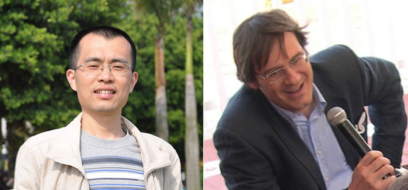| qualitas1998.net
|
 Palermo
and
Fozhou, 1-Dec-2015 - The
Journal of Physical Chemistry C publishes today a research
paper
from the teams Yi-Jun
Xu at Fuzhou University and Mario
Pagliaro at Italy's Research Council on the photocatalytic
reduction of carbon dioxide with water
in the gas-phase under solar light irradiation.
Palermo
and
Fozhou, 1-Dec-2015 - The
Journal of Physical Chemistry C publishes today a research
paper
from the teams Yi-Jun
Xu at Fuzhou University and Mario
Pagliaro at Italy's Research Council on the photocatalytic
reduction of carbon dioxide with water
in the gas-phase under solar light irradiation.
This seminal work describes a new
catalyst comprised of core–shell structured TiO2@SiO2 composites
synthesized via a simple sol–gel method which is remarkbly more
photoactive than bare titania toward CO2 reduction.
A variety of carefully blank tests in which the very same system were carried out without CO2 (and with and without O2 and water, or under nitrogen, etc) in order to check for potential product formation from carbon containing contaminants. No CO and H2 formation was detected pointing to authentic photoreduction observations.
"This
work -- comment the Authors -- will
inspire
further work in utilizing the silica coating method as well as
other proper core–shell strategies to tune the activity and selectivity
of semiconductor-based materials for artificial photoreduction of
carbon dioxide to value-added solar fuels".
Once a sufficiently active, low cost photocatalyst will be available, mankind will be able to convert carbon dioxide and water produced by hydrocarbon combustion back into carbon monoxide and hydrogen, from which practically every organic chemical can be derived from well known Fischer-Tropsch chemistry dating back to the early part of the 20th century still carried out at petrochemical plants worldwide.
Professor Yi-Jun Xu
leads in China a world's leading research
Group
in photocatalysis, whose outcomes include a number of new catalysts
suitable including artificial photoredox processes including
degradation of pollutants, selective organic transformation (e.g.,
selective C-H activation and oxidation of glycerol in water), water
splitting and photoreduction of CO2 to solar fuels, which are
intimately related to the key issues on energy and environment that we
strive to resolve today.
The Group is renowned also for having
developed various strategies on harnessing the structure and electronic
features of graphene toward enhanced photoactivity.
Dr Pagliaro leads in Sicily a research
Group which is today one of Europe's
primary research centres in the field of nano- and sustainable
chemistry.
Go to Latest News